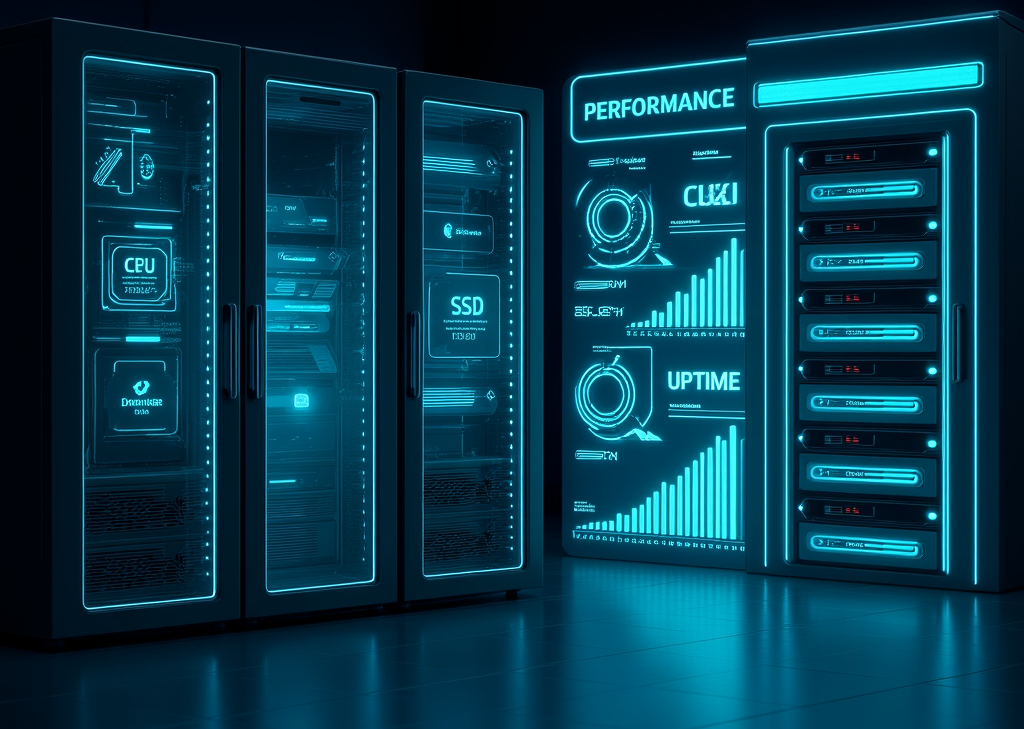How server hardware affects hosting reliability
Meta description:
Discover how server hardware impacts hosting reliability through performance, downtime prevention, and hardware quality, guiding your choice for optimal hosting.
Introduction
Server hardware is the backbone of any hosting environment and plays a critical role in ensuring hosting reliability. Understanding how the choice, maintenance, and upgrades of server hardware affect hosting performance and uptime is essential for businesses seeking a stable and secure web presence.
How server hardware influences hosting reliability
1. The impact of server hardware components on hosting performance
Server hardware quality and specifications directly influence hosting reliability and speed. Key components make all the difference:
-
Processors (CPU): Imagine your server as a power plant, where a high-performance CPU is the powerful generator, ensuring fast data processing and handling multiple requests without breaking a sweat. Reduced latency and quicker response times are the obvious outcomes.
-
Memory (RAM): Ever been stuck waiting for a webpage to load? That’s what insufficient or slow RAM can do. With ample, speedy RAM, your server retrieves data swiftly, ensuring that your website runs smoothly, even during peak traffic.
-
Storage: Visualize the experience of flipping through a book versus scrolling through a website. Instant access is king! The type of storage you choose—be it SSD, NVMe, or good old HDD—determines how fast your site will load. Traditional hard drives can leave visitors yawning, whereas SSDs and NVMe drives make for an exhilarating experience.
-
Power Supply Units (PSU): A reliable PSU acts as an unsung hero, preventing outages caused by power failures. Picture your website going down during an important launch—nightmare, right? Redundant power supplies keep the lights on, even when the unexpected strikes.
-
Motherboards and Cooling Systems: The foundation of your server speaks volumes about its longevity. Strong motherboards paired with efficient cooling systems stave off overheating and prevent hardware failures, ensuring your server is the rock that users lean on.
Using enterprise-grade, brand-new components from reputable manufacturers injects reliability into your system, while the temptation of cheap, used, or mismatched hardware can quickly lead to a descent into performance chaos and nagging downtimes.
2. Hardware upgrades and lifecycle management
Regularly updating server hardware is key to maintaining hosting reliability and adapting to increasing workload demands. Let’s break it down:
-
Improved performance: Think of it like upgrading from a rusty old bike to the latest model. Newer hardware architectures slash response times and gracefully carry larger workloads.
-
Increased resources: As your customer base grows, you need a server that can handle the volume. Enhanced processing power and memory allow you to serve more clients simultaneously and keep them satisfied.
-
Enhanced security and data protection: In a world where data breaches are as common as the air we breathe, modern servers come equipped with top-notch backup and failover capabilities to protect sensitive information.
-
Energy efficiency: Why pay more for electricity? Modern servers are designed with energy efficiency in mind, reducing operational costs through better cooling and optimized power management.
Servers typically have an optimal lifecycle of about five years, after which performance and reliability tend to go south. Managing this lifecycle effectively is not just about upgrading; it’s about planning for it.
3. Identifying and preventing hardware failures
Imagine the panic: your server suddenly goes down. Common hardware failures stem from components like hard drives, power supplies, and motherboards. Triggers are often trivial— overheating, wear and tear, or even physical damage. Here’s how to minimize risks:
-
Conduct routine hardware diagnostic tests and visual inspections. Like regular health check-ups, staying on top of your hardware's condition can catch issues before they snowball.
-
Implement fault-tolerant designs, such as RAID configurations and redundant components, which act like safety nets, ensuring that if one component fails, others can take over.
-
Ensure proper environmental control: Just as we thrive in comfortable temperatures, servers require climate control to flourish. Keeping temperature and humidity within the recommended ranges extends hardware life.
-
Stay alert for early signs of wear or malfunction and resolve them. It’s less about waiting for a fire alarm and more about keeping the flames at bay.
Proactive maintenance and failover strategies help sustain hosting reliability by catching and resolving hardware issues early on.
4. Server management practices affecting reliability
Beyond physical hardware, management and configuration play pivotal roles in ensuring uptime:
-
Choosing between managed or unmanaged hosting affects how hardware is maintained. Managed hosting often means you’re in good hands with experts watching over the systems.
-
Scalable hardware setups allow seamless upgrade paths as demand grows. Think of it like adding lanes to a highway as traffic increases—essential for keeping your visitors moving smoothly.
-
Reliable connectivity options, such as ample Ethernet ports and expansions, prevent network bottlenecks that could hinder service availability.
Hosting providers that invest in premium hardware combined with consistent maintenance protocols regularly deliver higher reliability and customer satisfaction. There’s a confidence that comes from knowing your server is as reliable as the sunrise.
In this vast digital ocean, where every bit of data is a drop in the wave, it’s essential to navigate wisely. The choices made in server hardware ripple through every interaction, shaping user experiences and business success. Each component is not merely a cog in the wheel; it's a promise to every user that they will have a reliable, satisfying encounter.
FINDDOMAIN.GE (Internet services LLC) is a very interesting and rapidly developing IT company. The main directions are: web development, domain and web hosting. It also offers clients sub-services and outsourcing related to the main services.
BEST OFFERS:
Do you want to create your own company website or create your own online business on the Internet?
– WEB HOSTING
– DOMAIN REGISTRATION
– WEB DEVELOPMENT
– SITE BUILDER



5. The Role of Data Center Environment in Hosting Reliability
The environment in which servers are housed significantly influences their performance and reliability. A data center is not merely a collection of servers; it’s a carefully orchestrated ecosystem designed for efficiency and durability. Let’s examine some crucial aspects:
-
Temperature Control: Maintaining optimal temperatures is essential. Too hot? You risk overheating components. Too cold? You invite condensation. A well-managed cooling system ensures that servers operate within optimal temperature ranges, promoting longevity and consistent performance.
-
Humidity Levels: Similar to temperature, humidity levels must be monitored. Humidity that's too high can lead to water damage, while too low can encourage static electricity buildup, damaging sensitive components. Keeping humidity between 45% and 55% is ideal for most servers.
-
Fire Suppression Systems: In a world where digital data can crumple like paper, it’s important to have advanced fire suppression systems. Traditional sprinklers can damage hardware, but systems like inert gas or pre-action sprinklers ensure that fire safety doesn’t come at the cost of server integrity.
-
Physical Security: Data breaches often start with physical access. Security measures like biometric access, surveillance cameras, and controlled entryways protect hardware from unwanted tampering and enhance overall reliability.
6. Choosing the Right Hosting Provider
Selecting a hosting provider is more than just comparing prices. It’s about understanding how their hardware choices and maintenance philosophies align with your reliability needs. Here’s what to contemplate:
-
Hardware Quality and Specifications: Investigate the type of hardware they use. Are they using enterprise-grade components? Understanding their investment in quality can be a telltale sign of potential reliability.
-
Uptime Guarantees: Check the uptime guarantees offered by providers. A host boasting a 99.9% uptime guarantee is making a promise that they’ll ensure your website remains online the vast majority of the time. Anything less may be a red flag.
-
Support and Maintenance Practices: Does the provider offer 24/7 support? Their responsiveness during hardware failures can dramatically influence your operation's reliability.
-
Customization Options: Some businesses will need specific hardware configurations, particularly if they anticipate rapid growth. Look for providers that allow customization to cater to your unique demands.
7. Monitoring and Analytics for Proactive Reliability
Monitoring is the lifeblood of reliability. You can't manage what you don’t measure. Here are the key components that should be maintained:
-
Performance Monitoring Tools: Tools like Nagios or Zabbix track server performance metrics in real-time—like CPU load, memory usage, disk health, and network status. They provide alerts before issues become critical, allowing for timely intervention.
-
Logging and Analytics: Continuously logging server activities can give insights into patterns and help detect problems before they escalate into downtime. Tools such as ELK Stack (Elasticsearch, Logstash, Kibana) or Grafana can transform this data into understandable visuals.
-
Regular Audits: Conducting systematic assessments of hardware and software not only ensures compliance but can pinpoint areas requiring fixes or enhancements. Regular audits can reveal hardware vulnerabilities or outdated software that may compromise your reliability.
8. Emphasizing Redundancy
When it comes to hosting reliability, redundancy isn’t just a buzzword; it’s a strategy. Here’s how implementing redundancy can strengthen your environment:
-
Data Redundancy: Utilizing RAID configurations can prevent data loss in the event of a disk failure. Regularly scheduled backups ensure that in the event of data corruption, recovery is just a few clicks away.
-
Geographic Redundancy: Having backup servers in multiple locations can protect against natural disasters or localized outages. If one area goes offline, traffic can be re-routed seamlessly, ensuring service continues.
-
Networking Redundancy: Multiple internet connections from different providers help keep services available, minimizing the risk of downtime due to a single point of failure.
By ensuring redundancy in every aspect of your hosting environment, you create an intricate safety net that supports reliability.
In conclusion, server hardware’s influence on hosting reliability can’t be overstated. From the choice of high-performance components to diligent monitoring and adopting robust redundancy strategies, every detail counts. Investing in quality hardware, maintaining best practices, and understanding your hosting environment are pathways to achieving high availability and satisfied users.
As technology continues evolving, so do the complexities of managing reliable hosting solutions. Staying informed and adaptable will ensure your operations thrive amid the digital chaos.
Relevant Video Links:
References:
- Server Performance Considerations
- Best Practices for Server Maintenance
- Exploring Redundancy in Hosting
- Optimizing Data Center Environment
- Choosing the Right Hosting Provider
- Tools for Performance Monitoring
- Understanding RAID Configurations
- Proactive Approaches to Hosting Reliability
FINDDOMAIN.GE (Internet services LLC) is a very interesting and rapidly developing IT company. The main directions are: web development, domain and web hosting. It also offers clients sub-services and outsourcing related to the main services.
BEST OFFERS:
Do you want to create your own company website or create your own online business on the Internet?
– WEB HOSTING
– DOMAIN REGISTRATION
– WEB DEVELOPMENT
– SITE BUILDER






![Web Development Services in [Local Area] for E-commerce](https://besthosting.ge/wp-content/uploads/2025/08/web-development-services-ecommerce-local-area.jpg)

![Small Business Website Development in [City/Neighborhood]](https://besthosting.ge/wp-content/uploads/2025/08/small-business-website-development-in-city-neighborhood.jpg)